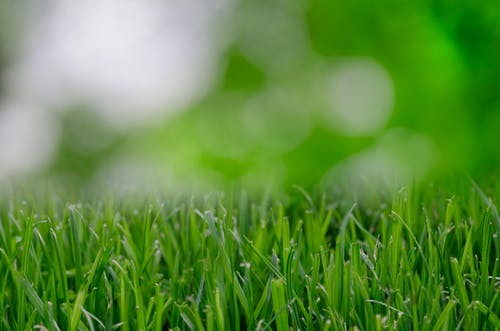Organic Practices for a Greener Lawn

While most of us are still under “stay at home orders” we’d like to provide you with some ways to maintain your lawn in an eco-friendly manner. Instead of reaching for the fertilizer when your lawn has brown spots, patchy areas or generally doesn’t look as lush and green as you’d like, take a look at the following ways you can improve both the health and appearance of your lawn in a sustainable way.
Aerate the Soil: Lawns receive frequent foot traffic, even if just from mowing, and very little seasonal aeration. This can lead to compacted soil and poor lawn health. If you can’t stick a trowel in your lawn, it’s likely time to aerate to help air reach the roots of the turf. Then, top-dress the lawn with organic compost and overseed to promote denser turf growth.
Water Less Often, More Deep: Overwatering leads to “lazy” turf roots that are close to the surface of the soil, where they can absorb frequent irrigation. Watering less often but more deeply causes the grasses to put energy into growing deeper roots to search for water. This leads to more resilient lawn grass that is better able to withstand drought. To wean a lawn off frequent water, postpone watering until you start to see the first signs of stress — yellowing grass — and then water deeply.
Rake In Compost: Compost and compost tea work to add nutrients back to the soil, creating stronger, healthier turf. In early fall, apply a relatively thin (about 1 inch) layer of compost over turf grass, ideally after core-aeration (which leaves handy holes for the compost), and then rake it into the grass to help it settle. Water to help it sink in. Compost tea or other organic lawn corrections can be added throughout the growing season, according to package directions.
Mow Less Frequently: Allowing grasses to grow taller between mowing can help improve turf health and create more resilient plants that can go longer between waterings. Plus, if you’re using an electric or gas-powered mower, passing on mowings can help conserve resources — and save you a garden chore.
Leave Grass Clippings Where They Fall: Instead of raking up grass clippings, go ahead and leave them on the turf, where the tiny pieces will break down and add nutrients back to the soil. Similarly, in fall you can set a lawn mower on the “mulch” setting and go over a scattering of fallen leaves on the grass to add additional organic material to the lawn.
Overseed Bare Areas: If areas of your lawn look worn, or the turf is less full than you’d like, try overseeding, when grass seed is planted directly in an existing lawn. Overseeding creates a denser stand of turf, which can out-compete weeds. Overseeding is best done in spring or early fall.
To overseed, start by mowing the lawn with the lawnmower set to a low height. Then, scatter lawn seed mixed with sand evenly over the existing turf and top with a thin layer of compost. Rake thoroughly to help the seeds make their way through the turf and make contact with soil. Then, water consistently until seeds germinate — which can be from seven to 21 days, depending on growing conditions.
Fight Pests Organically: Pests, such as ants and beetles, can be treated with beneficial insects rather than pesticides. Some nurseries sell organic pest-control kits that come with nematodes — tiny, worm-like beneficial organisms that prey on garden pests — that can be applied on lawns and other areas of the garden.
Fungal infections in a lawn can be treated through mechanical methods such as raking and mowing.
Switch to No-Mow Native Grasses or Meadow Blends: If you’re considering replacing your lawn or planting a new one, consider what type of turf makes the most sense for your sun exposure and soil type, plus the amount of foot traffic. There are pros and cons to each type of turf.
Generally, no-mow turf mixes have a beautiful, fluid look and require less water than traditional turf, as well as fewer mowings — although you often can crop them short if a more traditional look is what you’re after.
Native grasses and meadow blends offer the most benefits to native pollinators and wildlife in the form of habitat, food sources and nesting materials. Plus, native meadow blends often add color to beds and a lovely, naturalistic look when in bloom. They can be mowed down to a more traditional turf height later on in the season.
These are easy ways to ditch the pesticides and fertilizers and adopt eco-friendly practices that keep your lawn flourishing.
